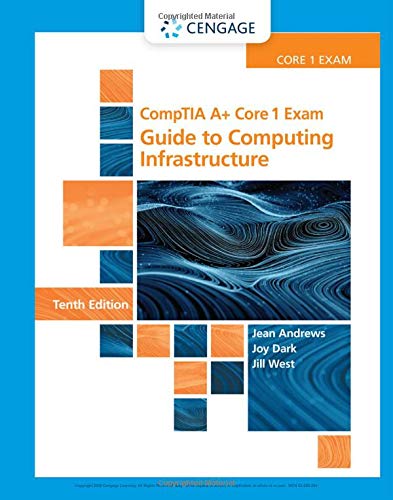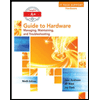
A+ Guide To It Technical Support
10th Edition
ISBN: 9780357108291
Author: ANDREWS, Jean.
Publisher: Cengage,
expand_more
expand_more
format_list_bulleted
Expert Solution & Answer
Chapter 5, Problem 6TC
Explanation of Solution
Given:
RAID arrays.
To find: The RAID technique which does not lose data.
Solution:
RAID...
Expert Solution & Answer
Trending nowThis is a popular solution!

Students have asked these similar questions
Distributed Systems: Consistency Models
fer to page 45 for problems on data consistency.
structions:
Compare different consistency models (e.g., strong, eventual, causal) for distributed databases.
Evaluate the trade-offs between availability and consistency in a given use case.
Propose the most appropriate model for the scenario and explain your reasoning.
Link: [https://drive.google.com/file/d/1wKSrun-GlxirS31Z9qoHazb9tC440AZF/view?usp=sharing]
Operating Systems: Deadlock Detection
fer to page 25 for problems on deadlock concepts.
structions:
• Given a system resource allocation graph, determine if a deadlock exists.
If a deadlock exists, identify the processes and resources involved.
Suggest strategies to prevent or resolve the deadlock and explain their trade-offs.
Link: [https://drive.google.com/file/d/1wKSrun-GlxirS31Z9qoHazb9tC440 AZF/view?usp=sharing]
Artificial Intelligence: Heuristic Evaluation
fer to page 55 for problems on Al search algorithms.
tructions:
Given a search problem, propose and evaluate a heuristic function.
Compare its performance to other heuristics based on search cost and solution quality.
Justify why the chosen heuristic is admissible and/or consistent.
Link: [https://drive.google.com/file/d/1wKSrun-GlxirS31Z9qoHazb9tC440 AZF/view?usp=sharing]
Chapter 5 Solutions
A+ Guide To It Technical Support
Knowledge Booster
Similar questions
- Refer to page 75 for graph-related problems. Instructions: • Implement a greedy graph coloring algorithm for the given graph. • Demonstrate the steps to assign colors while minimizing the chromatic number. • Analyze the time complexity and limitations of the approach. Link [https://drive.google.com/file/d/1wKSrun-GlxirS3IZ9qoHazb9tC440 AZF/view?usp=sharing]arrow_forwardRefer to page 150 for problems on socket programming. Instructions: • Develop a client-server application using sockets to exchange messages. • Implement both TCP and UDP communication and highlight their differences. • Test the program under different network conditions and analyze results. Link: [https://drive.google.com/file/d/1wKSrun-GlxirS31Z9qo Hazb9tC440AZF/view?usp=sharing]arrow_forwardRefer to page 80 for problems on white-box testing. Instructions: • Perform control flow testing for the given program, drawing the control flow graph (CFG). • Design test cases to achieve statement, branch, and path coverage. • Justify the adequacy of your test cases using the CFG. Link: [https://drive.google.com/file/d/1wKSrun-GlxirS3IZ9qo Hazb9tC440 AZF/view?usp=sharing]arrow_forward
- Refer to page 10 for problems on parsing. Instructions: • Design a top-down parser for the given grammar (e.g., recursive descent or LL(1)). • Compute the FIRST and FOLLOW sets and construct the parsing table if applicable. • Parse a sample input string and explain the derivation step-by-step. Link: [https://drive.google.com/file/d/1wKSrun-GlxirS31Z9qoHazb9tC440 AZF/view?usp=sharing]arrow_forwardRefer to page 20 for problems related to finite automata. Instructions: • Design a deterministic finite automaton (DFA) or nondeterministic finite automaton (NFA) for the given language. • Minimize the DFA and show all steps, including state merging. • Verify that the automaton accepts the correct language by testing with sample strings. Link: [https://drive.google.com/file/d/1wKSrun-GlxirS31Z9qo Hazb9tC440AZF/view?usp=sharing]arrow_forwardRefer to page 60 for solving the Knapsack problem using dynamic programming. Instructions: • Implement the dynamic programming approach for the 0/1 Knapsack problem. Clearly define the recurrence relation and show the construction of the DP table. Verify your solution by tracing the selected items for a given weight limit. Link: [https://drive.google.com/file/d/1wKSrun-GlxirS3IZ9qoHazb9tC440AZF/view?usp=sharing]arrow_forward
- Refer to page 70 for problems related to process synchronization. Instructions: • • Solve a synchronization problem using semaphores or monitors (e.g., Producer-Consumer, Readers-Writers). Write pseudocode for the solution and explain the critical section management. • Ensure the solution avoids deadlock and starvation. Test with an example scenario. Link: [https://drive.google.com/file/d/1wKSrun-GlxirS31Z9qo Hazb9tC440AZF/view?usp=sharing]arrow_forward15 points Save ARS Consider the following scenario in which host 10.0.0.1 is communicating with an external SMTP mail server at IP address 128.119.40.186. NAT translation table WAN side addr LAN side addr (c), 5051 (d), 3031 S: (e),5051 SMTP B D (f.(g) 10.0.0.4 server 138.76.29.7 128.119.40.186 (a) is the source IP address at A, and its value. S: (a),3031 D: (b), 25 10.0.0.1 A 10.0.0.2. 1. 138.76.29.7 10.0.0.3arrow_forward6.3A-3. Multiple Access protocols (3). Consider the figure below, which shows the arrival of 6 messages for transmission at different multiple access wireless nodes at times t=0.1, 1.4, 1.8, 3.2, 3.3, 4.1. Each transmission requires exactly one time unit. 1 t=0.0 2 3 45 t=1.0 t-2.0 t-3.0 6 t=4.0 t-5.0 For the CSMA protocol (without collision detection), indicate which packets are successfully transmitted. You should assume that it takes .2 time units for a signal to propagate from one node to each of the other nodes. You can assume that if a packet experiences a collision or senses the channel busy, then that node will not attempt a retransmission of that packet until sometime after t=5. Hint: consider propagation times carefully here. (Note: You can find more examples of problems similar to this here B.] ☐ U ப 5 - 3 1 4 6 2arrow_forward
- Just wanted to know, if you had a scene graph, how do you get multiple components from a specific scene node within a scene graph? Like if I wanted to get a component from wheel from the scene graph, does that require traversing still? Like if a physics component requires a transform component and these two component are part of the same scene node. How does the physics component knows how to get the scene object's transform it is attached to, this being in a scene graph?arrow_forwardHow to develop a C program that receives the message sent by the provided program and displays the name and email included in the message on the screen?Here is the code of the program that sends the message for reference: typedef struct { long tipo; struct { char nome[50]; char email[40]; } dados;} MsgStruct; int main() { int msg_id, status; msg_id = msgget(1000, 0600 | IPC_CREAT); exit_on_error(msg_id, "Creation/Connection"); MsgStruct msg; msg.tipo = 5; strcpy(msg.dados.nome, "Pedro Silva"); strcpy(msg.dados.email, "pedro@sapo.pt"); status = msgsnd(msg_id, &msg, sizeof(msg.dados), 0); exit_on_error(status, "Send"); printf("Message sent!\n");}arrow_forward9. Let L₁=L(ab*aa), L₂=L(a*bba*). Find a regular expression for (L₁ UL2)*L2. 10. Show that the language is not regular. L= {a":n≥1} 11. Show a derivation tree for the string aabbbb with the grammar S→ABλ, A→aB, B→Sb. Give a verbal description of the language generated by this grammar.arrow_forward
arrow_back_ios
SEE MORE QUESTIONS
arrow_forward_ios
Recommended textbooks for you
 A+ Guide To It Technical SupportComputer ScienceISBN:9780357108291Author:ANDREWS, Jean.Publisher:Cengage,
A+ Guide To It Technical SupportComputer ScienceISBN:9780357108291Author:ANDREWS, Jean.Publisher:Cengage, Comptia A+ Core 1 Exam: Guide To Computing Infras...Computer ScienceISBN:9780357108376Author:Jean Andrews, Joy Dark, Jill WestPublisher:Cengage Learning
Comptia A+ Core 1 Exam: Guide To Computing Infras...Computer ScienceISBN:9780357108376Author:Jean Andrews, Joy Dark, Jill WestPublisher:Cengage Learning A+ Guide to Hardware (Standalone Book) (MindTap C...Computer ScienceISBN:9781305266452Author:Jean AndrewsPublisher:Cengage Learning
A+ Guide to Hardware (Standalone Book) (MindTap C...Computer ScienceISBN:9781305266452Author:Jean AndrewsPublisher:Cengage Learning

A+ Guide To It Technical Support
Computer Science
ISBN:9780357108291
Author:ANDREWS, Jean.
Publisher:Cengage,

Comptia A+ Core 1 Exam: Guide To Computing Infras...
Computer Science
ISBN:9780357108376
Author:Jean Andrews, Joy Dark, Jill West
Publisher:Cengage Learning


A+ Guide to Hardware (Standalone Book) (MindTap C...
Computer Science
ISBN:9781305266452
Author:Jean Andrews
Publisher:Cengage Learning